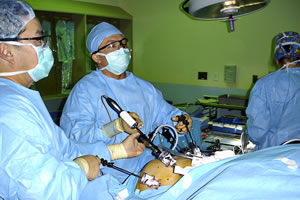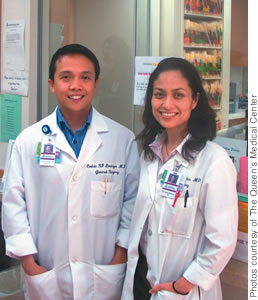Surgery Through One Tiny Incision
Interviewed by Melissa Moniz
Wednesday - December 03, 2008
E-mail this story | Print this page | Comments (0) | Archive
 Del.icio.us Share
Del.icio.us Share

Dr. Cedric Lorenzo
Director of Bariatric Surgery at The Queen’s Medical Center and assistant professor at John A. Burns School of Medicine
Interviewed by Melissa Moniz
Where did you receive your schooling and training?
I am a proud graduate of the public school system. I went to Waipahu High School and graduated in 1992. I finished my undergraduate at UH-Manoa, as well as my medical school training at the John A. Burns School of Medicine. I did my surgery residency here with the University of Hawaii residency surgery program and then went on to study minimally invasive surgery and bariatric surgery at Northwestern University in Chicago. I then went on to do a endoscopy and NOTES fellowship at Oregon Health and Science University in Portland.
How long have you been practicing?
I just got back home to Hawaii about five months ago.
Was it always your goal to come back home?
I always wanted to come back to Hawaii because my family and friends are here. There’s nothing like coming back home. And, for me, working with all the cultures I grew up with is that much more special.
Can you discuss what bariatric surgery is?
Bariatric surgery is basically surgery for weight loss. This is something that has happened since the 1950s. Because of the health problems that come with morbid obesity, these surgeries have become very popular. Because the population has realized how bad a problem morbid obesity is, more and more people are choosing bariatric surgery.
How much of your practice is bariatrics and how much is other types of surgical procedures?
I think right now it’s 50/50, although my practice is geared toward minimally invasive surgeries where we perform the surgeries through very small incisions. That includes everything from removing colons to taking out various organs, to treating patients for bad reflux.
Can you talk about the new surgical procedure now being done at Queen’s that uses just a single incision?
It is called SILS, which stands for Single Incision Laparoscopic Surgery, and there’s another version of it called Single Port Access Surgery, or SPAS.
The procedure is basically taking laparoscopic surgery, which was traditionally done through many ports, and decreasing it to only one port so you can just have a single incision. Most of the procedures are being done through the belly button so that whatever scar will get hidden in the belly button, so it gives the appearance that there’s no scar at all.
This is, for the most part, less than a year old. I started researching the procedure back when I was in Portland. When I finally got back here, Dr. Racquel Bueno and I started doing it with select patients, which has been basically for gallbladders. Gallbladders traditionally were done by a large incision right under the right rib cage and people would go home with a lot of pain. Since the early ‘90s, it’s been done laparoscopically, and that usually means using four holes - one near the belly button and three more. For the most part, people would go home within a day and the recovery time was less than a week, which is good, but there was still a need to minimize the incisions. So with SILS and SPAS we are able to use our body’s natural scar, which is the belly button, and still do the same procedure. It also then becomes more cosmetically appealing.

|
Can you discuss any other benefits of the new surgical procedure?
By reducing the number of incisions you also can reduce pain. There’s also the chance of less wound infection because you have fewer wounds to worry about. And there’s also less chance of the wound separating or the opportunity for hernia, and so the patient could then benefit by recovery time.
How many of these procedures have you and Dr. Racquel Bueno done here in Hawaii?
We’ve done about eight or nine of these procedures. It was all gallbladders. But there are surgeons in other areas like OB/GYN who also are thinking of doing it.
What has been the feedback from patients who had this surgical procedure done?
They loved it. I think a lot of them were actually amazed. One of the patients even mentioned that they knew we were going to take it out of one hole, but where is the incision? A lot of people liked it because it’s cosmetically appealing and they were back to work quickly. The patients also experienced less pain. With the traditional laparoscopic method, some patients do experience some pain in the upper part of their body that most of our patients didn’t have because it was just a single incision by the belly button.
Within your field, are there other problems that could be treated through this new procedure, or is it limited to gall-bladders?
Actually, other programs on the Mainland have done types of weight-management surgeries. Others have taken out spleens, appendixes and colons through the single incision. So I think the scope is just growing.

|
Do you see Queen’s using this procedure for bariatrics, such as the gastric bypass, the LAP-BAND or the sleeve?
I think we will. What we’re doing right now is we’re studying the companies because there are various companies that offer products for each type of procedure. So we’re trying to figure out the best way to approach this, and do we have ideal candidates for this. Once we go through all the steps, and also once technology catches up, then we’ll be able to do any type of surgery through this procedure. So again, it’s just us getting familiar with all the instruments and technology catching up.
Do you see the SILS and SPAS procedures eventually becoming the standard level of care?
Absolutely. As patients demand less and less scarring and technology improving at the rate it’s been improving, it quite possibly will become the standard level of care for most abdominal operations.
This information is provided as educational and is not intended as a substitute for consultation with a physician. For questions, consult your physician.
E-mail this story | Print this page | Comments (0) | Archive
Most Recent Comment(s):













